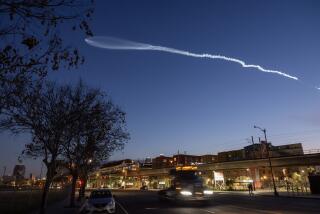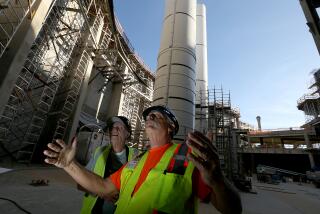Experts Differ on Cause of Tragedy : But Solid Rocket Motors Continue to Be a Prime Suspect
- Share via
Aerospace experts differed sharply Friday on whether the powerful solid rocket motors that lifted the space shuttle Challenger off the launching pad Tuesday were the likely cause of its disastrous explosion just 73 seconds later.
The boosters continue to be a prime suspect in the tragedy because films of the disaster seem to show flame coming out of the side of one of the boosters. The flame then appears to hit the shuttle’s huge external fuel tank, which exploded in a fireball that claimed seven lives.
Boosters Remained Aloft
Some engineers contend that the booster could not have survived a rupture in its casing, and since both boosters remained aloft after the shuttle exploded, they could not be at fault.
Others say the explosion of the Challenger is consistent with a malfunction in the solid booster rockets.
Neither position is supported with significant amounts of hard evidence because the National Aeronautics and Space Administration is still gathering data as well as remnants of the ill-fated spacecraft. It is a process that could take months.
Will Take Time
“The answer is not easy,” said Fred Culick, a solid rocket expert at Caltech. Even if investigators are able to learn what failed, it will take much longer to learn why, and how to prevent it from happening again, he said.
One expert who has analyzed other rocket failures said Friday that data recorded by NASA during Challenger’s brief flight Tuesday may provide a clue. The accident could have occurred if the space shuttle’s main engines, fueled by liquid fuel in the massive external tank, attempted to offset an imbalance between the two solid boosters because one booster had lost part of its thrust through a burnout in its side.
The expert, who refused to be identified, said a burn-through of one of the solid rocket boosters is a potential cause of the tragedy.
Engine Pivoted Slightly
Other experts working on the investigation said computer-enhanced videotapes show that one of the orbiter’s liquid-fueled engines pivoted slightly just prior to the explosion.
Although the two reports may be unrelated, the pivoting of the engine would be consistent with an effort by the main engines’ guidance system to offset an imbalance in the solid rocket boosters.
But several other experts said the rockets did not behave as they should have if one had sustained a major failure.
“It’s hard to square (the theory of a booster failure) with the way those things flew off afterwards,” said one top expert who asked not to be identified. He said that if the casing had failed on one of the rockets, it most likely would have immediately veered wildly away.
No Wild Maneuvers
“Instead, I saw the two solids flying away almost under control,” he said. One of the rockets did apparently turn back toward shore, forcing range safety officers to destroy the boosters, but neither exhibited the kind of wild maneuvers that would be expected if a rupture had occurred, he said.
Culick agreed that a rupture of the casing would have caused the rocket to destroy itself almost immediately because the hot fuel would no longer be under control.
“I would be suspicious of case failure because those become catastrophic very quickly (and the rocket itself is destroyed),” Culick said. “I know of a number of cases where that has happened. The rocket just goes.”
The solid rocket motors are built by Morton Thiokol of Brigham City, Utah, the largest manufacturer of solid rockets in the world.
Sole Supplier of Rockets
Morton Thiokol is the sole supplier of booster rockets for the shuttle, a situation NASA would like to change. The space agency is encouraging four other companies to develop boosters in competition with Morton Thiokol in hopes of bringing the cost of the boosters down.
In February, 1984, two communications satellites, the Westar 6 and the Palapa, failed to achieve their proper orbit when upper stage rocket motors produced by Morton Thiokol failed.
The solid fuel rocket motor was part of an upper stage known as a “payload assist module,” designed to boost satellites from low Earth orbit where they are released by the space shuttle to a geosynchronous orbit 22,300 miles above Earth.
An exhaustive investigation found the cause of the problem to be a burnout in the rocket motor exhaust nozzle, which was constructed of a composite fabric and resin material.
The satellites were dramatically retrieved from space by the shuttle crew in a multimillion-dollar space spectacular and returned to Earth.
Rocket Design Has Evolved
The design of the solid fuel rockets has evolved through the shuttle program, begining in April of 1983 on the first flight of the Challenger. From that flight on, all solid rocket boosters used steel casings that had been shaved by about 0.02 to 0.04 of an inch in thickness, according to a shuttle guidebook published by Rockwell International, which built the spacecraft. That reduced the weight of each rocket by 4,000 pounds.
Two flights later, NASA launched the Challenger with boosters that had been equipped with new exhaust nozzles designed to increase the thrust of the rockets. The throat of those nozzles had been decreased by four inches, thus increasing the velocity of the gases as they pass through the nozzle. The fuel was also changed to allow it to burn faster.
When the rockets were recovered from the ocean after the launching, NASA officials were shocked to learn that the exhaust nozzles had come within about 10 seconds of burning through. The problem was corrected and it has not occurred on any boosters used since.
Major Design Change
The continuing need to reduce weight in the space shuttle system will be particularly important if NASA begins launching shuttles from Vandenberg Air Force Base, as originally planned for later this year. The payloads will be heavy, forcing another major design change in the boosters.
Shuttles launched into an equatorial orbit from Cape Canaveral benefit from the rotational thrust of the Earth. In a sense, the Earth’s rotation throws the spacecraft, just as an object thrown from a moving car is affected by the movement of the vehicle.
But that will not be the case at Vandenberg, where shuttles will be launched into a polar orbit and thus cannot benefit from the equatorial rotation of the Earth.
Beginning with the first launching from Vandenberg, NASA had planned to use new solid rocket boosters that are encased in a cylinder made of filaments of plastic reinforced with graphite fiber. NASA has completed a series of test firings of the new cases at the Marshall Space Flight Center in Huntsville, Ala., and they are scheduled to be used on all flights out of Vandenberg and high performance launchings from the cape to carry extra heavy payloads into orbit.
The new cases weigh about 33,000 pounds less than the metal cases, and that savings can be converted into cargo.
Improper assemblage of rocket booster theorized. Page 18.
More to Read
Sign up for Essential California
The most important California stories and recommendations in your inbox every morning.
You may occasionally receive promotional content from the Los Angeles Times.











